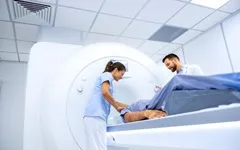How to Get a Radiology Certification: Tips and Advice to Consider
October-05-2024

Radiology can be an extremely fulfilling career path with a multitude of branching specialties and opportunities. However, it's such a broad field that it can seem overwhelming when you're trying to get your credentials in order and start your career.
Today, we're going to go over some of the options at your disposal, practical tips to help you succeed when seeking certification, and advice that can help you kickstart your radiology career efficiently and effectively.
Read on and find out how to get a radiology certification.
The ARRT and Different Specialties
Radiology is an umbrella term, and it covers a wide variety of imaging specialties. You can pursue a single specialty, or you can opt to earn credentials in a variety of radiology-based fields.
Some notable options are:
- mammography imagery which includes performing breast exam screenings,
- bone density imaging which includes imaging and examining the state of a patient's bone structure due to various injuries or conditions,
- vascular-interventional imaging which involves imaging the heart to diagnose budding heart problems and help medical professionals determine the right solutions for a patient's heart conditions.
It's not uncommon for radiologists to become qualified in various roles, but for reasons we'll highlight shortly, it is optimal to spend some time considering what you want to do initially.
Preparing Yourself for Success with Certification
Regardless of how you choose to start branching your radiology career, preparation is crucial. The exams are difficult, and the ARRT exam pass rate is only 72%.
You want to be part of that 72% on your first try. So, here are some practical tips to help you succeed.
1: Focus on One Certification at a Time
While you can eventually build up an impressive list of radiology credentials that leave your career open to a variety of opportunities, it's best to focus one each step one at a time.
Not only do some exams require you to have demonstrated your qualifications with previous exams, but even if they don't, they're not easy undertakings.
Each exam you can take is hours long with up to 200 questions, there is a fee that has to be paid to take the exam, and of course, your career's development is on the line.
Taking a focused approach and pursuing your career in steps rather than multitasking is the best way to ensure success.
2: Maintain Mental and Physical Health Leading Up to the Exam
One thing that many exam takers don't consider is the impact of their mental and physical health on their exam taking abilities.
There's a major difference between your ability to think clearly and perform at your best when you're tired, hungry, and stress compared to when you're at peak condition.
To optimize your performance without extra studying or spending, focus on these simple but effective strategies:
- Get a good night's rest each night
- Eat healthy to keep your body functioning at its peak
- Avoid stress as much as possible leading up to the exam

3: Take Practice Tests
Regardless of which radiology exam you're planning to take, it's crucial to take ARRT practice exams.
Practice exams are mock exams meant to emulate the exam you're pursuing. They feature similar questions, include a timer to help with time management and simulate the testing experience without any real stakes.
For example, if you take ARRT mammography practice tests, you can expect each practice test to go over the safety regulations and ethical practices of mammography radiology, the imaging process in various situations, and similar topics specific to mammography.
Practice exams are vital resources that ensure you're familiar with the exam before you take it. However, keep in mind that they're not copies of the real exam, the scoring scale changes regularly for the real exam, and not everything is going to perfectly mirror what you experience when you take the real deal.
You'll also still want to focus on traditional study methods and ensure that you have a solid grasp of the information you'll be tested on.
The Process of Taking an ARRT Exam
Taking an ARRT exam is fairly straightforward, but it's not as easy as simply logging onto a site, taking a test, and getting qualified.
Here are the steps you'll have to go through.
1: Determining Eligibility
First, you have to meet the eligibility requirements for the exam you're taking.
These vary depending on the certification you're pursuing, but in general, you'll need to have the certifications for lower-level radiology credentials, your general documentation for your career, education, identifying information, etc.
Because certifications are pursued in stages, you'll typically have the requirements you need unless you try to skip to a more advanced specialization. So, this is a straightforward step to get through.
2: Fee Payment
There is a fee for your exam. For the ARRT:
- Primary (R, N, T, MR, S) $225
- Postprimary (M, CT, MR, BD, CI, VI, VS, BS, R.R.A.) $225
- Postprimary (CT, MR, BD, or VS—using NMTCB as supporting category) $450
- Postprimary (MR, VS, or BS—using ARDMS as supporting category) $450
3: Tutorial
Once you've met all requirements and paid your fee, you'll take the exam. This starts with a brief tutorial period that familiarizes you with the exam structure, requirements for success, etc.
This portion is unscored and solely meant to help you succeed.
4: The Exam
The exam process can take up to 4 hours with a varying number of questions depending on the exact certification you're trying to qualify for. It's completed entirely online.

5: Post Exam Survey and Scoring
Once you've completed your exam, it's normal to have to do a brief survey that helps design future test iterations and gives test makers insight into their designs.
You'll receive an unofficial score upfront, but it will take time for the exam to be properly judged. The initial score is typically fairly accurate, though.
Get an Edge on Your Career Certification Exams with Exam Edge
Before getting a radiology certification, it's essential to equip yourself with the right tools and preparation.
Make sure to try the practice tests and resources at Exam Edge, the #1 online practice tests resource, to give yourself the best chance at success possible.
Blogs related to: How to Get a Radiology Certification: Tips and Advice to Consider










